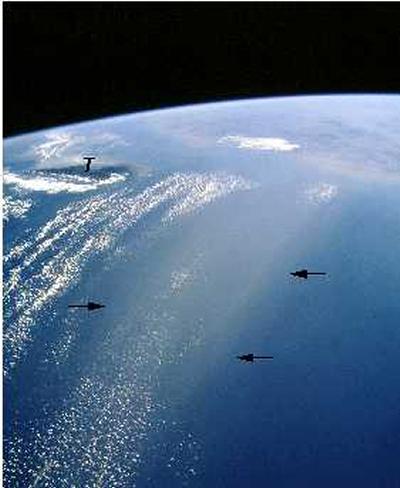May 22, 2003
Aerosols’ effects could change current understanding of global climate change
Atmospheric aerosols, airborne particles that reflect the sun’s heat away from Earth and into space, are part of everyday life. They are in the haze of air pollution, in plumes of smoke from forest fires and in ash clouds from erupting volcanoes.
But a new study says the cooling effect of man-made aerosols could throw a monkey wrench into the current understanding of climate change.
“It’s possible that the total forcing from human activity to date is small, or even negative. That’s unlikely but possible, and we should not rule it out at this point,” said Theodore Anderson, a UW research meteorologist.
Climate forcing results when an external factor imposes a change on the planet’s heat balance. Aerosols produced by human activity can exert both positive and negative forcing, but it is believed that their overall effect is negative (positive forcing adds heat and tends to warm the climate; negative forcing removes heat and tends to cool the climate).
The particles reflect sunlight back into space and also modify the properties of clouds, causing them to reflect more sunlight back into space. These patchy effects add up to a global impact that tends to offset climate warming caused by human-produced greenhouse gases, such as carbon dioxide.
Despite extensive study, it is still highly uncertain just how big a factor the negative forcing of aerosols is in the overall climate-change picture. At issue is whether computer and mathematical models that use a variety of factors to gauge climate change have properly accounted for the uncertainty.
Anderson is lead author of a paper, published in the May 16 edition of Science, arguing that climate modelers have failed to consider the full magnitude of potential forcing that has been found in aerosol research. Instead, the authors say, modelers have used only aerosol-forcing values that allow their models to reproduce the recorded global temperature increase, and have ignored values that do not fit the temperature record.
“That’s fine as a best-guess scenario, but what if the high-magnitude negative aerosol forcing values turn out to be correct? That would mean current interpretations of 20th century warming would be erroneous, and so projections of future climate change might be in error as well. We need to at least consider this possibility,” Anderson said.
He noted that if all climate forcing from outside factors so far has had a cumulative negative effect, then climate warming that already has occurred cannot be from human activity but rather must be the result of natural climate fluctuation. On the other hand, if the total forcing to date has been very small but still caused the observed warming, then the Earth’s climate might be much more sensitive to forced change than climate models currently indicate.
Improved knowledge of climate forcing could radically alter the current understanding of climate change, the authors say. And that improved knowledge could be available in the near future from a new generation of aerosol-sensing satellites. A big step comes next year when the National Aeronautics and Space Administration and the French space agency launch a satellite called CALIPSO, which will provide detailed maps of the atmosphere’s aerosol content. CALIPSO will fly in formation with other satellites measuring energy variations and other factors.
“We can expect surprises and breakthroughs in quantifying aerosol forcing, but we don’t know what to expect,” said Robert Charlson, a UW atmospheric chemist and a co-author of the paper in Science. “We will be in a position where we will be better able to disprove or support the climate models.”
Other authors include Stephen Schwartz of Brookhaven National Laboratory in Upton, N.Y.; Reto Knutti of the University of Bern in Switzerland; Olivier Boucher of the Université des Sciences et Technologies de Lille in France; Henning Rodhe of Stockholm University in Sweden; and Jost Heintzenberg of the Institute for Tropospheric Research in Leipzig, Germany.
The researchers do not contend that human-caused climate change isn’t a real danger. In fact, they make the opposite case.
The ability of aerosols to counteract greenhouse warming is very limited because the particles remain in the air for only a week or so, Anderson said, while greenhouse gases remain for a century or more. So while there currently might be a rough balance between the two, the greenhouse gases are accumulating and are sure to win out in the future, having a much larger long-term impact on climate.
It is critical to figure out how the Earth’s climate responds to positive forcing, Anderson said. One of the best ways to do that is to improve the knowledge of current climate forcing from human activities. But even with the arrival of new satellites, achieving this advance in knowledge will require strong commitment from the scientific community and funding agencies, he said. Coordinated global measurements are needed to properly interpret data from the satellites, and compiling that information into an improved global understanding will be a major challenge.
“We already know that we will have to seriously limit carbon dioxide emissions,” Charlson said. “But, until we do a better job quantifying the total forcing, we will not know how rapidly carbon dioxide controls need to be implemented, nor will we know how much climate change we can expect in spite of these controls.”

